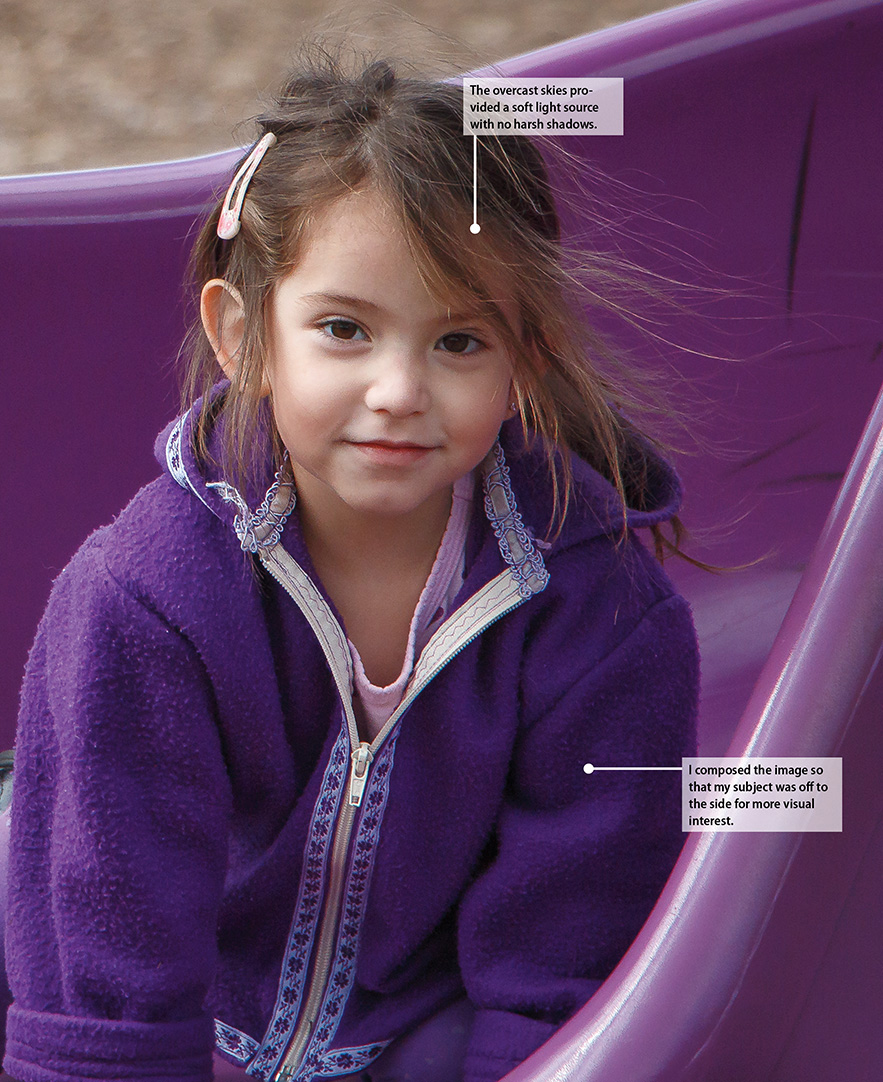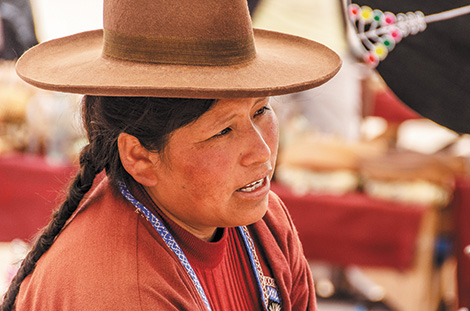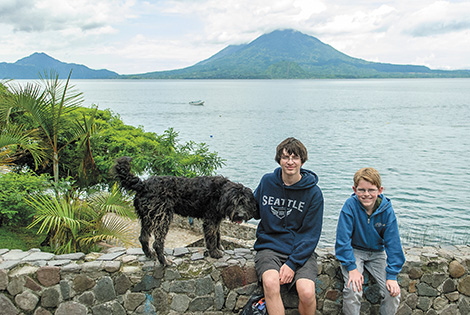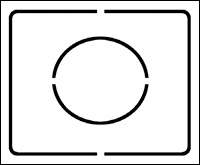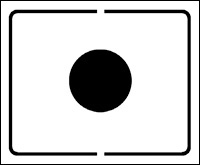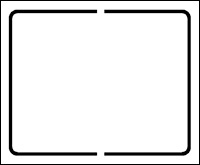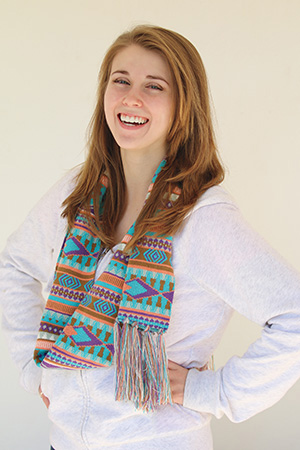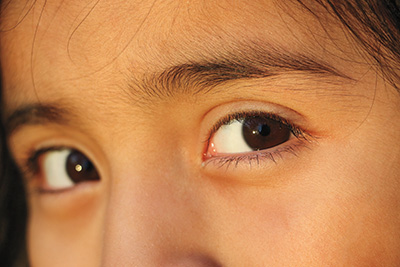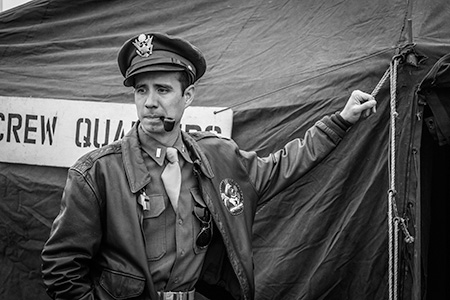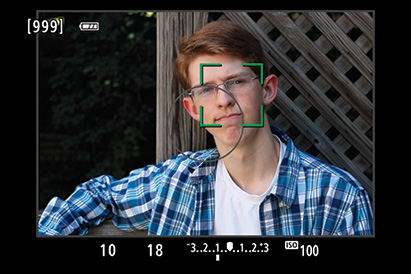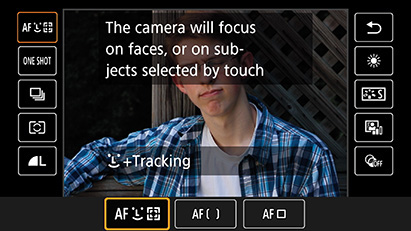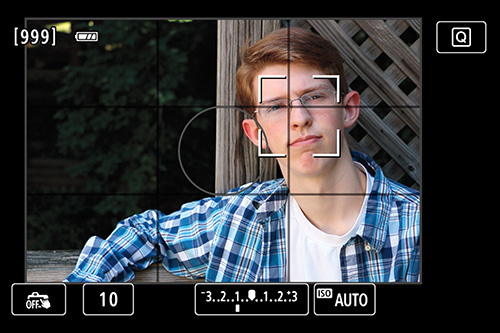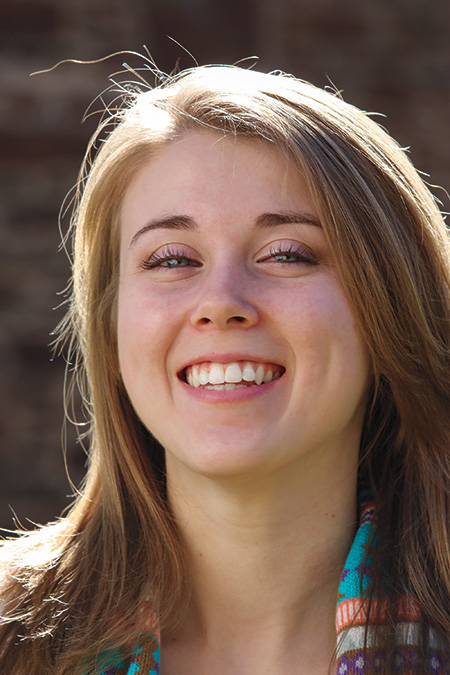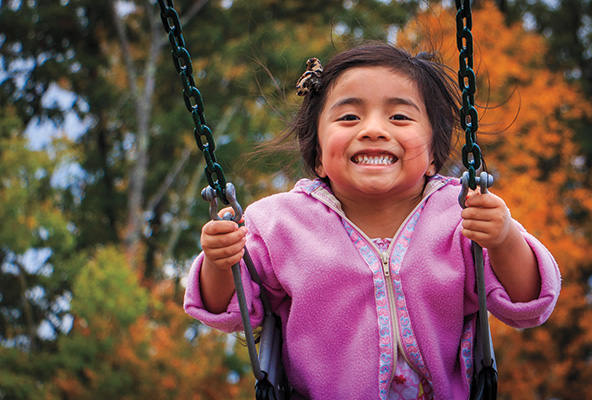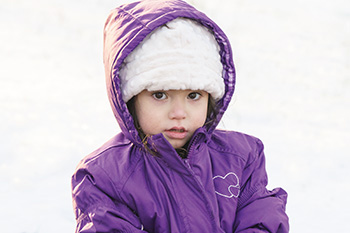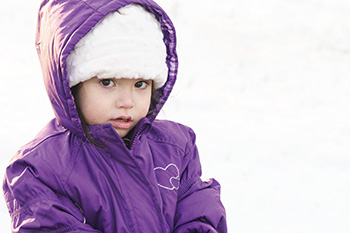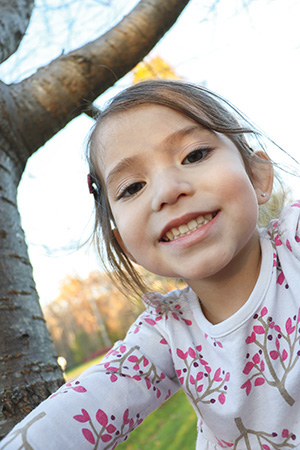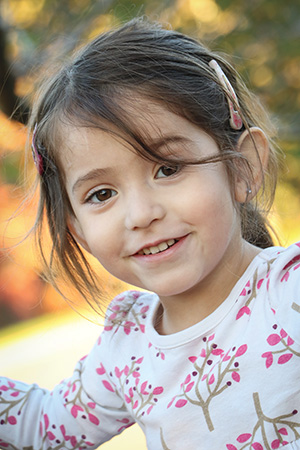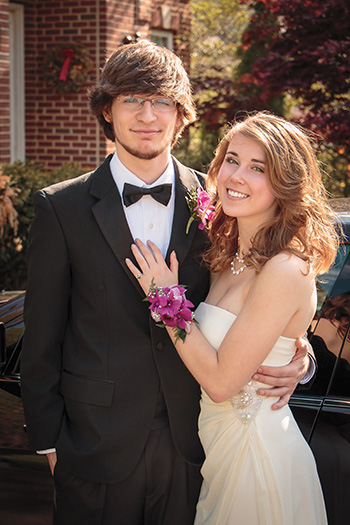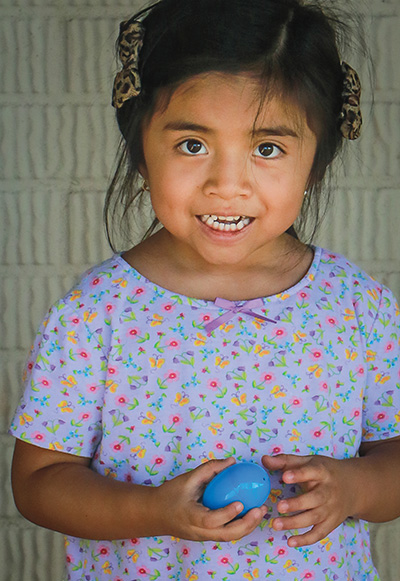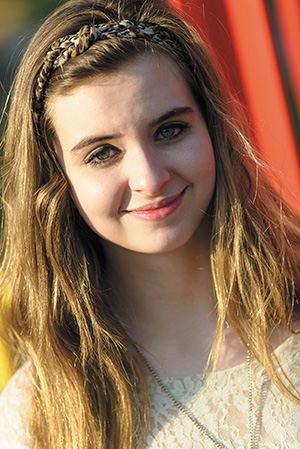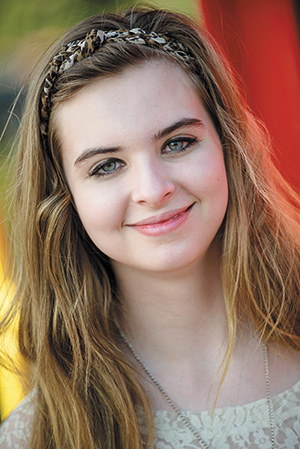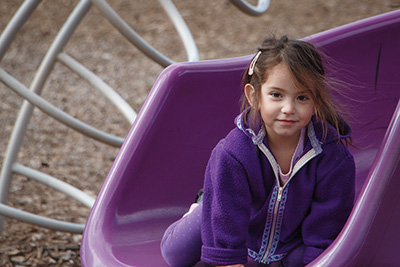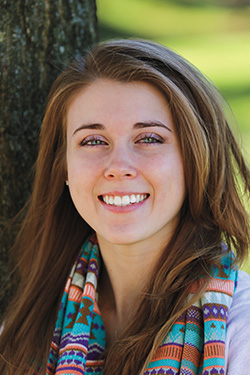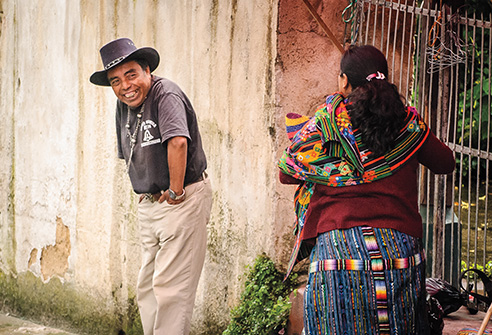6. Say Cheese!
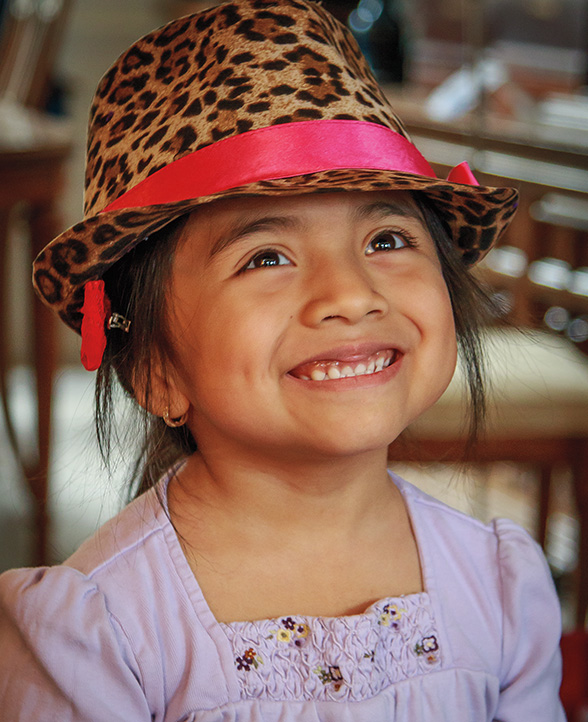
ISO 2000 • 1/50 sec. • f/4 • 65mm lens
Settings and Features to Make Great Portraits
Taking pictures of people is one of the joys of photography. You will experience a great sense of accomplishment when you capture the spirit and personality of someone in a photograph. At the same time, you have a great responsibility because the person in front of the camera is depending on you to make them look good. You can’t always change how someone looks, but you can control the way you photograph that individual. In this chapter, we will explore some camera features and techniques that can help you create compelling portraits.
Poring Over the Picture
I can’t stand stiff, posed shots of children. They always seem to look so unnatural, mainly because kids just like to move. I like to take advantage of that by taking children’s portraits that put them in an environment where they are comfortable and more apt to give me real expressions. Whether it’s on a park slide or up in a tree, you will always get a better photo when they are having fun.
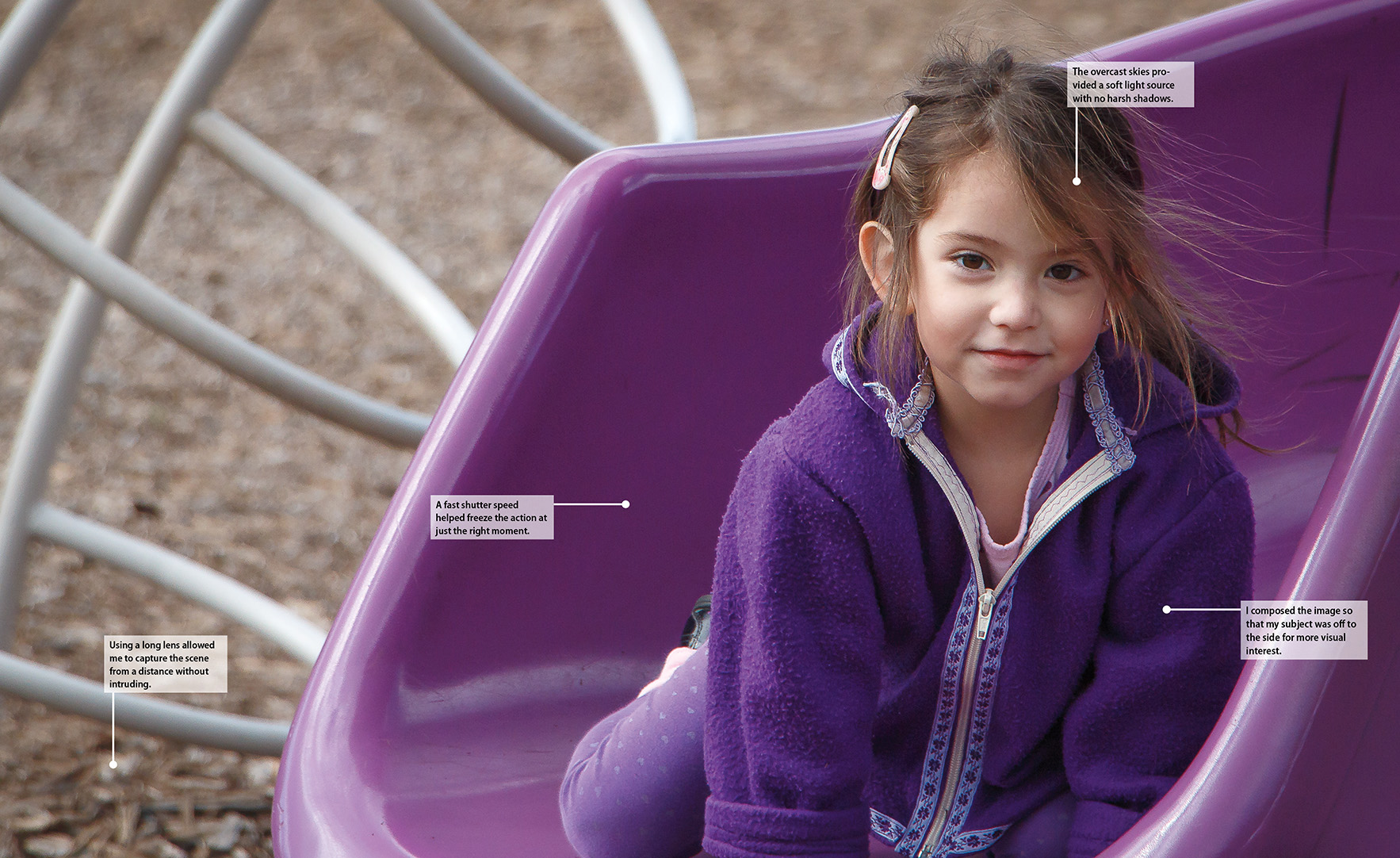
ISO 400 • 1/1000 sec. • f/5.6 • 135mm lens

Poring Over the Picture
One of the great advantages of using a camera like the T6s / T6i is that there are so many creative tools right at your fingertips. Sure, I could have taken a color photo of this World War II reenactor, but why not create an image that was more in line with his period dress, like a black-and-white image? Strip out the color, and the monochrome lets you create great black-and-white portraits that are tailored to the scene. You are limited only by your imagination.
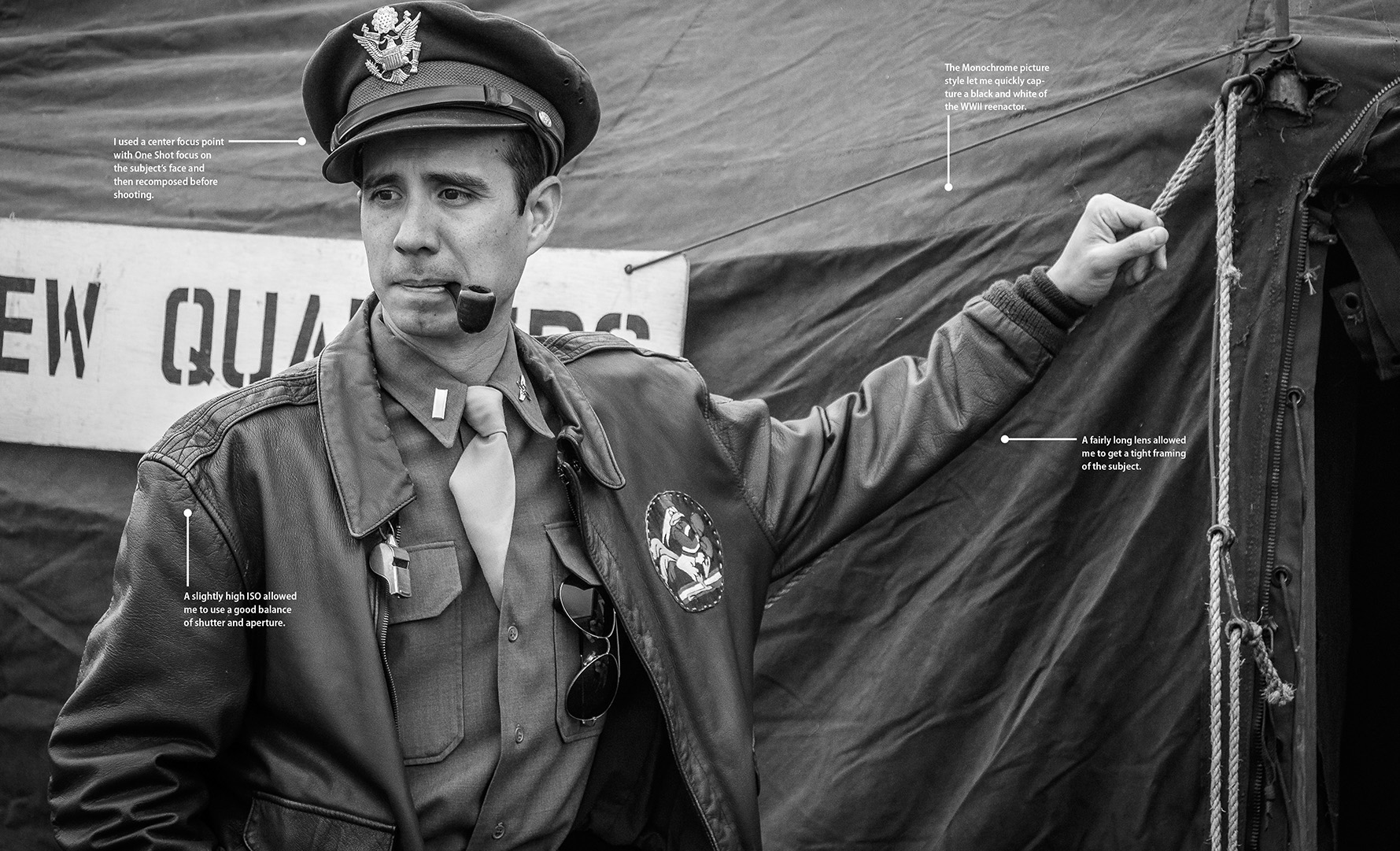
ISO 800 • 1/500 sec. • f/5.6 • 92mm lens
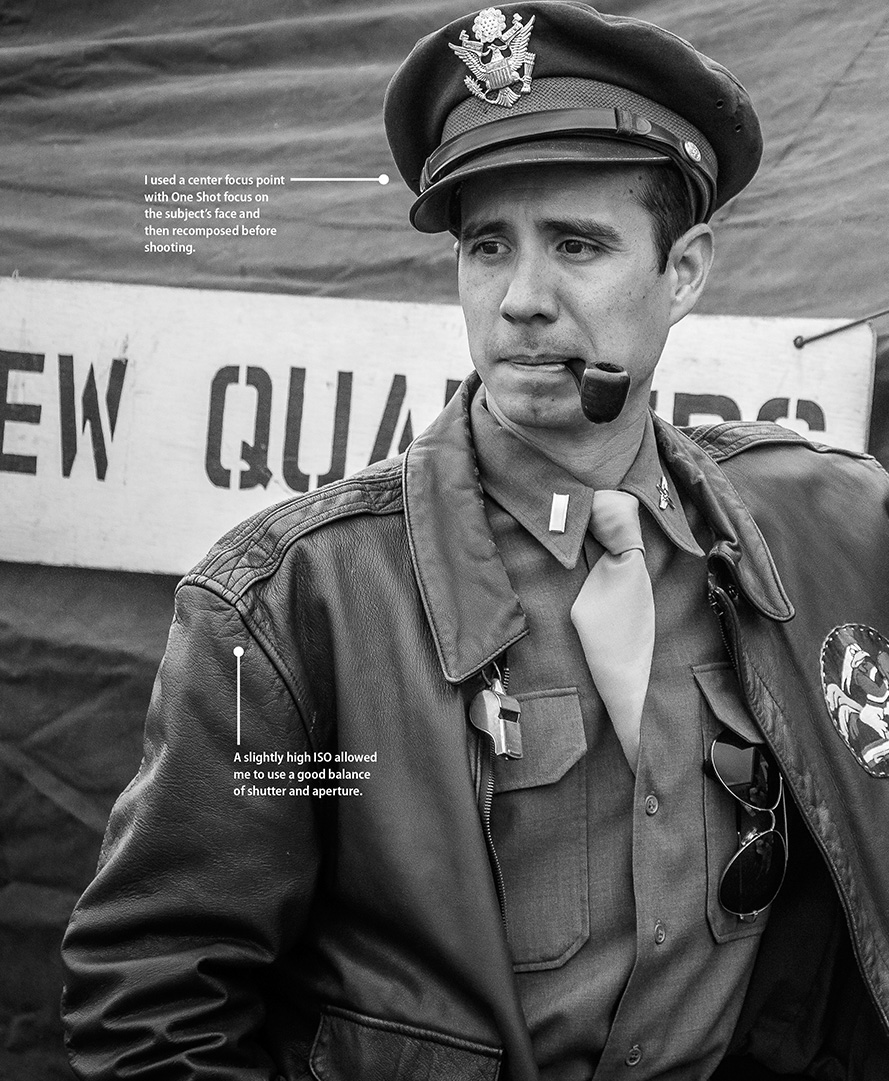
Automatic Portrait Mode
In Chapter 3, “The Basic Zone,” we reviewed all of the automatic modes in the Basic zone. One of them, Portrait mode, is dedicated to shooting portraits. Although this is not my preferred camera setting, it is a great jumping-off point for those who are just starting out. The key to using this mode is to understand what is going on with the camera so that when you venture further into portrait photography, you can expand on the settings and get the most from your camera and, more importantly, your subject.
Whether you are photographing an individual or a group, the emphasis should always be on the subject. Portrait mode uses a larger aperture setting to keep the depth of field very narrow, which means that the background will appear slightly blurred or out of focus. To take full advantage of this effect, use a medium- to telephoto-length lens (Figure 6.1). Also, keep a pretty close distance to your subject. If you shoot from too far away, the narrow depth of field will not be as effective.
ISO 400 • 1/400 sec. • f/5.6 • 200mm lens
Figure 6.1 Portrait mode works best when combined with a medium or long lens.
Using Aperture Priority Mode
If you took a poll of portrait photographers to see which shooting mode was most often used for portraits, the answer would certainly be Aperture Priority (Av) mode. Selecting the right aperture is important for placing the most critically sharp area of the photo on your subject, while simultaneously blurring all of the distracting background clutter (Figure 6.2). Not only will a large aperture give the narrowest depth of field, it will also allow you to shoot in lower light levels at lower ISO settings.
ISO 100 • 1/640 sec. • f/4 • 47mm lens
Figure 6.2 Using a large aperture, especially with a longer lens, blurs distracting background details.
This isn’t to say that you have to use the largest aperture on your lens. A good place to begin is f/5.6. This will give you enough depth of field to keep the entire face in focus, while providing enough blur to eliminate distractions in the background. This isn’t a hard-and-fast setting; it’s just a good, all-around number to start with. Your aperture might change depending on the focal length of the lens you are using and on the amount of blur that you want for your foreground and background elements.
Go wide for environmental portraits
There will be times when your subject’s environment is of great significance to the story you want to tell. This might mean using a smaller aperture to get more detail in the background or foreground. Once again, by using Av mode, you can set your aperture to a higher f-stop, such as f/8 or f/11, and include the important details of the scene that surrounds your subject.
Using a wider-than-normal lens can also assist in getting more depth of field as well as showing the surrounding area. A wide-angle lens requires less stopping down of the aperture to achieve an acceptable depth of field. This is due to the fact that wide-angle lenses are covering a greater area, so the depth of field appears to cover a greater percentage of the scene.
A wider lens might also be necessary to relay more information about the scenery (Figure 6.3). Select a lens length that is wide enough to tell the story but not so wide that you distort the subject. There’s nothing quite as unflattering as giving someone a big, distorted nose (unless you are going for that sort of look). When shooting a portrait with a wide-angle lens, keep the subject away from the edge of the frame. This will reduce the distortion, especially in very wide focal lengths. As the lens length increases, distortion will be reduced. I generally don’t like to go wider than about 24mm for portraits. For standard portraits, I prefer a 55mm lens setting.
ISO 400 • 1/800 sec. • f/5.6 • 18mm lens
Figure 6.3 A wide-angle lens allows you to capture more of the environment in the scene without having to increase the distance between you and the subject.
Metering Modes for Portraits
For most portrait situations, the Evaluative metering mode is ideal. (For more on how metering works, see the “Metering Basics” sidebar.) This mode measures light values from all portions of the viewfinder and then establishes a proper exposure for the scene. The only problem that you might encounter when using this metering mode is when you have very light or dark backgrounds in your portrait shots.
In these instances, the meter might be fooled into using the wrong exposure information because it will be trying to lighten or darken the entire scene based on the prominence of dark or light areas (Figure 6.8). You can deal with this in one of two ways. You can use the Exposure Compensation feature, which we cover in Chapter 7,” Landscape Photography,” to dial in adjustments for over- and underexposure. Or you can change the metering mode from Evaluative to Partial or Center-Weighted metering. The Partial metering mode only uses the center area of the viewfinder (about 9 percent) to get its exposure information. This is the best way to achieve proper exposure for most portraits; metering off of skin tones, averaged with hair and clothing, will often give a more accurate exposure (Figure 6.9). This metering mode is also great to use when the subject is strongly backlit.
ISO 200 • 1/1600 sec. • f/2.8 • 70mm lens
Figure 6.8 The light background color and clothing fooled the meter into choosing a slightly underexposed setting for the photo.
ISO 200 • 1/640 sec. • f/2.8 • 70mm lens
Figure 6.9 When I switch to either the Partial or the Center-Weighted metering mode, the camera will ignore much of the background and add a little more time to the exposure.
Setting your metering mode to Partial metering
1. Press the Q button on the back of the camera to activate the Quick Control screen.
2. Move the selection to the metering mode icon (A).

3. Use the Main dial to scroll through the metering modes until you find the symbol for Partial metering mode. The names of the different modes will appear near the bottom of the screen. If you press the Set button a second time, you can see all of the available metering modes (B).
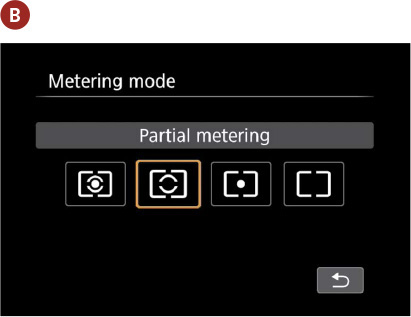
4. Press the Set button to return to shooting mode.
Using the AE Lock Feature
There will often be times when your subject is not in the center of the frame but you still want to use the Partial metering mode. So how can you get an accurate reading if the subject isn’t in the center? Try using the AE (Auto Exposure) Lock feature to hold the exposure setting while you recompose.
AE Lock lets you use the exposure setting from any portion of the scene that you think is appropriate, and then lock that setting in regardless of how the scene looks when you recompose. An example of this would be when you’re shooting a photograph of someone and a large amount of blue sky appears in the picture. Normally, the meter might be fooled by all that bright sky and try to reduce the exposure. Using AE Lock, you can establish the correct metering by zooming in on the subject (or even pointing the camera toward the ground), taking the meter reading and locking it in with AE Lock, and then recomposing and taking your photo with the locked-in exposure.
Shooting with the AE Lock feature
1. Find the AE Lock (![]() ) button on the back of the camera and place your thumb on it.
) button on the back of the camera and place your thumb on it.
2. While looking through the viewfinder, place the center focus point on your subject.
3. Press and hold the AE Lock button to get a meter reading. A star will appear in your viewfinder, letting you know that the exposure has been locked.
4. Recompose your shot, and then take the photo.
5. To take more than one photo without having to take another meter reading, just hold down the AE Lock button until you are done using the meter setting.
Focusing: The Eyes Have It
It has been said that the eyes are the windows to the soul, and nothing could be truer when you are taking a photograph of someone (Figure 6.10). You could have the perfect composition and exposure, but if the eyes aren’t sharp the entire image suffers. Although there are many different focusing modes to choose from on your T6s / T6i, for portrait work you can’t beat One Shot mode using a single focusing point. One Shot focusing will establish a single focus for the lens and then hold it until you take the photograph; the other focusing modes continue focusing until the photograph is taken. The single-point selection lets you place the focusing point right on your subject’s eye and set that spot as the critical focus point. Using One Shot mode lets you get that focus and recompose all in one motion.
ISO 400 • 1/250 sec. • f/2.8 • 56mm lens
Figure 6.10 When photographing people, you should almost always place the emphasis on the eyes, specifically the eye closest to the camera.
Setting up for One Shot focusing mode
1. Press the right button (Cross key), the one labeled AF, on the back of your camera.
2. Rotate the Main dial or use the left/right Cross keys to change the focusing mode to One Shot; then press the Set button.
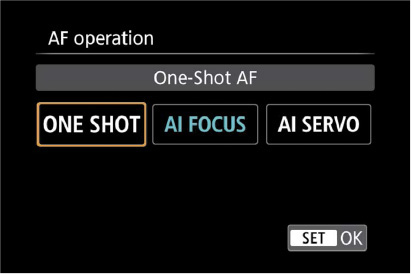
Setting your focus to a single point
1. Press the Focus Point Selection button (at the top right on the back of the camera) and then look in your viewfinder.
2. Press your up/down/left/right buttons (Cross keys) and watch the illuminated point change as you press the buttons. Select any single point from among the 19 available points.
3. If you see a cluster of points or none at all, it means you are not in single-point manual selection mode. Just press the mode selection button on the top of the camera to change to the single-point mode.
4. Now, to shoot using this focus point, place that point on your subject’s eye, and press the shutter button halfway until you hear the chirp. While still holding the shutter button down halfway, recompose and take your shot.

I typically use the center point for focus selection. I find it easier to place that point directly on the location where my critical focus should be established and then recompose the shot. Even though the single point can be selected from any of the focus points, it typically takes longer to figure out where that point should be in relation to my subject. By using the center point, I can quickly establish focus and get on with my shooting.
Classic Black-and-White Portraits
There is something timeless about a black-and-white portrait. It eliminates the distraction of color and puts all the emphasis on the subject. To get great black and whites without having to resort to any image-processing software, set your picture style to Monochrome (Figure 6.11). You should know that the picture styles are automatically applied when shooting with the JPEG file format. If you are shooting in RAW, the picture that shows up on your rear LCD display will look black and white, but it will appear as a color image when you open it in your Digital Photo Professional software. You can use the software to apply the Monochrome, or any other style, to your RAW image within the image-editing software.
ISO 800 • 1/500 sec. • f/5.6 • 92mm lens
Figure 6.11 Getting high-quality black-and-white portraits is as simple as setting the picture style to Monochrome.
The real key to using the Monochrome picture style is to customize it for your portrait subject. The style can be changed to alter the sharpness and contrast. For women, children, puppies, and anyone else who should look somewhat soft, set the Sharpness setting to 0 or 1. For old cowboys, longshoremen, and anyone else who you want to look really detailed, try a setting of 6 or 7. I typically like to leave Contrast at a setting of around –1 or –2. This gives me a nice range of tones throughout the image.
The other adjustment that you should experiment with changing is the picture style’s Filter effect. It can be set from None to one of the four available settings (Yellow, Orange, Red, and Green). Using the filters will have the effect of either lightening or darkening the skin tones. The Red and Yellow filters usually lighten skin, whereas the Green filter can make skin appear a bit darker. Experiment to see which one works best for your subjects.
Setting your picture style to Monochrome
1. Start by pressing the Picture Style button located on the down button (Cross key).
2. Use the Main dial to highlight the Monochrome setting, and lock it in by pressing the Set button (A).
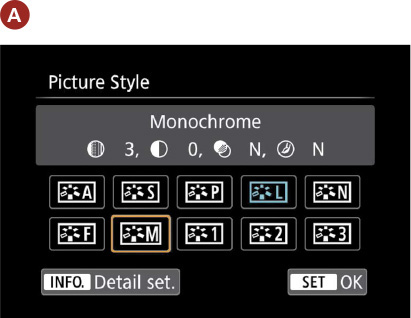
3. To customize the setting, follow steps 1 and 2 but instead of pressing the Set button, press the INFO button (located to the left of your viewfinder) to open the options screen.
4. Highlight the setting you would like to change and press the Set button (B).
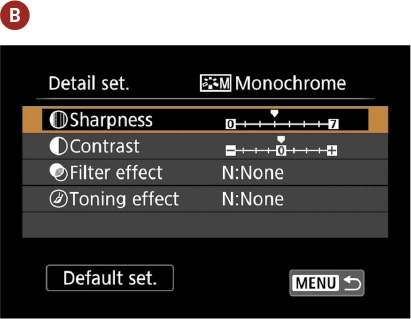
5. Now use the left/right button (Cross keys) to move the cursor to a new position on the scale (the default setting will remain marked with a gray arrow) and press the Set button (C).
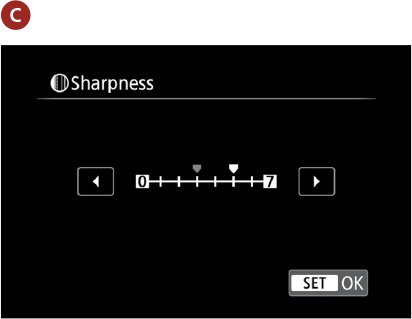
6. Perform the same process for the Filter effect option and press Set to lock in your change (D).
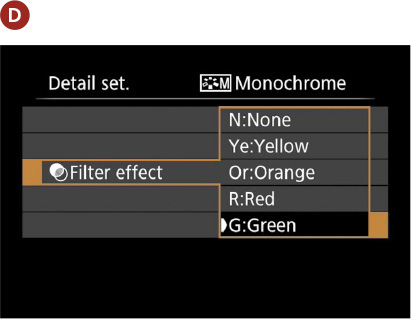
7. Once you are done making changes, just lightly press the shutter release button to exit. You can now start shooting with your new settings.
Your camera will continue to shoot with the Monochrome picture style until you change it to another setting. The changes you make to a picture style will remain as you set them until you change them back or reset the camera to its default settings.
The Portrait Picture Style for Better Skin Tones
As long as we are talking about picture styles for portraits, there is another style on your T6s / T6i that has been tuned specifically for this type of shooting: the Portrait picture style. To set this style on your camera, follow the same directions as earlier, except this time select the Portrait style instead of Monochrome. There are also individual options for the Portrait style that, like the Monochrome style, include sharpness and contrast. You can also change the saturation (how intense the colors will be) and color tone, which lets you change the skin tones from more reddish to more yellowish. I prefer brighter colors, so I like to boost the Saturation setting to +2 and leave everything else at the defaults. You won’t be able to use the same adjustments for everyone, especially when it comes to color tone, so do some experimenting to see what works best.
Detecting Faces with Live View
Face detection in digital cameras has been around for a few years, but it’s still a new concept in the world of the DSLR. Your T6s / T6i has three different autofocus modes for Live View: Quick, Live, and my personal favorite, Face Detection. These modes are different from the standard modes like One Shot, AI Servo, and AI Focus. Face Detection mode is probably the slowest of the Live View focusing modes, so I use it mostly when I am working with a tripod or my subjects are going to remain fairly still. When you turn on Live View with Face Detection focusing, the camera does an amazing thing: it zeroes in on any face appearing on the LCD and places a box around it (Figure 6.12). I’m not sure how it works; it just does.
If there is more than one face in the frame, the box will appear over just one of them, but it will have little arrows to the side of it. Just press the left/right buttons (Cross keys) from side to side to make the box jump from one face to the other until you have selected the one that you want to focus on. If you have the touchscreen enabled, you can simply tap on the face you that you want the focus box to appear on.
Setting up and shooting with Live View and Face Detection focusing
1. Press the Menu button and use the Main dial to highlight the fourth shooting menu screen. Then highlight the Live View shoot option and make sure it is set to Enable.
2. Press the Menu button to exit the menu mode and get ready for shooting.
3. Activate the Live View function by pressing the Live View button located on the back of the camera, to the right of the viewfinder.
4. Point your camera at a person and watch as the frame appears over the face in the LCD.
5. Press and hold the shutter release button halfway to focus on the face and wait until you hear the confirmation chirp.
6. Press the shutter button fully to take the photograph.
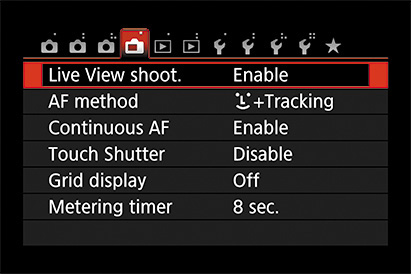
If you are having difficulty getting a face to focus, you can press the Q button (for the Quick Control screen) to activate the Live View options and make sure the AF option on the left side of the screen is highlighted. Then just turn the Main dial to switch from the Face Detection focusing mode to AF Live mode (Figure 6.13). This will bring up a focus point in the center of the screen that you can toggle to a new location. You can also tap on the LCD in touchscreen mode to pick your focus point right on the LCD screen.
Using Live View’s Grid overlay
There is another benefit to using Live View: the Grid overlay. This is a feature that actually places a grid over your image, dividing it into thirds, which can be of great benefit in properly composing your image.
Setting up Live View’s Grid option
1. Press the Menu button and then use the Main dial to get to the fourth shooting menu screen.
2. Using the Cross keys, scroll down to Grid display and press Set (A).

3. Scroll down to Grid display, press Set, and then choose Grid 1 (B).
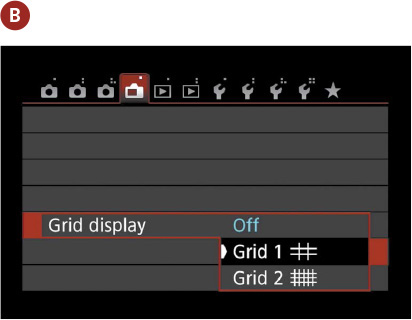
Now, when you activate Live View, you will see the one-third grid overlay superimposed on the rear display (Figure 6.14). This effect only shows up on the display and will not be visible in your final image.
Using Fill Flash to Reduce Shadows
A common problem when taking pictures of people outside, especially during the midday hours, is that the overhead sun can create dark shadows under the eyes and chin. You could have your subject turn his or her face to the sun, but that is usually considered cruel and unusual punishment. So how can you have your subject’s back to the sun and still get a decent exposure of the face? Try turning on your flash to fill in the shadows. This also works well when you are photographing someone with a ball cap or someone who has a bright scene behind them (Figure 6.15). The fill flash helps lighten the subject so they don’t appear in shadow, while providing a really nice catchlight in the eyes.
ISO 200 • 1/160 sec. • f/9 • 160mm lens
Figure 6.15 The subject was positioned with the sun at her back with some fill flash added to lighten her face.
The key to using the flash as a fill is to not use it on full power. If you do, the camera will try to balance the flash with the daylight, and you will get a very flat and featureless face.
Setting up and shooting with fill flash
1. Press the pop-up flash button to raise your pop-up flash into the ready position.
2. Press the Q button to activate the Quick Control screen.
3. Use the up/down/left/right buttons (Cross keys) to position the cursor over the Flash Exposure Compensation option.
4. Use the Main dial to select the desired amount of flash compensation.
5. Lightly press the shutter release button to exit the Quick Control screen.
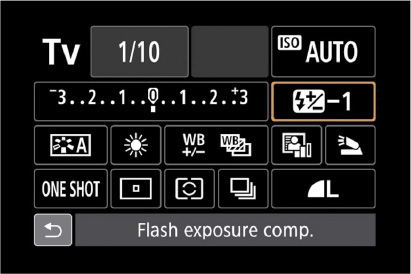
It might take you a few adjustments of the flash compensation to get just the right amount of flash for your subject. As a starting point, try using a -1 setting and then adjust from there. The flash will also be working with the camera’s metering system, so one adjustment won’t work for every scenario.
People on the Move
Not all portraits are shot with the subject sitting in a chair, posed and ready for the picture. Sometimes you might want to get an action shot that says something about the person, similar to an environmental portrait. Children, especially, just like to move. Why fight it? Set up an action portrait instead.
For the photo in Figure 6.16, I set my camera to Tv mode. I knew that there would be a good deal of movement involved, and I wanted to make sure that I had a fairly high shutter speed to freeze the action, so I set it to 1/500 of a second. I used a continuous focus mode, I had the drive mode set to Continuous, and I just started firing off shots as my subject was swinging away from me. I had quite a few throwaway shots, but I was able to get one that captured the peak of the action with the facial expression I was looking for.
ISO 400 • 1/500 sec. • f/5 • 62mm lens
Figure 6.16 Although I prefer to shoot my people shots in Aperture Priority, the key to this shot was using Shutter Priority.
Tips for Shooting Better Portraits
Before we get to the assignments for this chapter, I thought it might be a good idea to leave you with a few extra pointers on shooting portraits that don’t necessarily have anything specific to do with your camera. There are entire books that cover things like portrait lighting, posing, and so on. But here are a few pointers that will make your people pics look a lot better.
Avoid the center of the frame
This falls under the category of composition. Placing your subject in the middle of the frame is usually a pretty boring way of composing your portrait (Figure 6.17). Try moving them off to the side using the rule-of-thirds trick and you will end up with a much more interesting image (Figure 6.18).
ISO 400 • 1/100 sec. • f/5.6 • 120mm lens
Figure 6.17 Having the subject in the middle of the frame with so much empty space on the sides can make for a less-than-interesting portrait.
ISO 400 • 1/80 sec. • f/5.6 • 120mm lens
Figure 6.18 Try moving the subject off to the side for a more interesting composition.
Choose the right lens
Choosing the correct lens can make a huge impact on your portraits. A wide-angle lens can distort features of your subject, which can lead to an unflattering portrait (Figure 6.19). Select a longer focal length if you will be close to your subject (Figure 6.20).
ISO 400 • 1/200 sec. • f/3.5 • 18mm lens
Figure 6.19 At this close distance, the 18mm lens is distorting the subject’s face.
ISO 800 • 1/80 sec. • f/5.6 • 135mm lens
Figure 6.20 By zooming out to 135mm, I am able to remove the distortion for a much better photo.
Don’t cut them off at the knees
There is an old rule about photographing people: never crop a person at a joint. This means no cropping at the ankles or the knees or the hips for that matter. If you need to crop at the legs, the proper place to crop is mid-shin or mid-thigh (Figure 6.21).
ISO 400 • 1/640 sec. • f/6.3 • 300mm lens
Figure 6.21 A good crop for people is when it intersects at mid-thigh or mid-shin.
Use the frame
Have you ever noticed that most people are taller than they are wide? Turn your camera vertically for a more pleasing composition (Figure 6.22).
ISO 800 • 1/1600 sec. • f/5.6 • 80mm lens
Figure 6.22 Get in the habit of turning your camera to a vertical position when shooting portraits. This is also referred to as portrait orientation.
Sunblock for portraits
The midday sun can be harsh and can do unflattering things to people’s faces (Figure 6.23). If you can, find a shady spot out of the direct sunlight. You will get softer shadows, smoother skin tones, and better detail (Figure 6.24). This holds true for overcast skies as well. Just be sure to adjust your white balance accordingly.
ISO 100 • 1/800 sec. • f/3.2 • 180mm lens
Figure 6.23 The bright, direct sunlight looks too harsh on the subject’s face.
ISO 100 • 1/640 sec. • f/3.2 • 180mm lens
Figure 6.24 By moving my subject over just a couple of feet, I was able to get her out of the direct sun and into a much more flattering situation.
Get down on their level
If you want better pictures of children, don’t shoot from an adult’s eye level. Getting the camera down to the child’s level will make your images look more personal (Figure 6.25).
ISO 400 • 1/1000 sec. • f/5.6 • 135mm lens
Figure 6.25 Whenever you are taking photographs of children, get your camera down on their level for a less imposing view.
Don’t be afraid to get close
When you are taking someone’s picture, don’t be afraid of getting close and filling the frame (Figure 6.26). This doesn’t mean you have to shoot from a foot away; try zooming in to capture the details.
ISO 400 • 1/800 sec. • f/2.8 • 105mm lens
Figure 6.26 Filling the frame with the subject’s face can lead to a much more intimate portrait.
Try a long lens for candid shots
Putting a camera in someone’s face can elicit some unnatural results. People just feel a need to pose, or get nervous and stiff. If you really want to capture some nice portraits with a more candid feel, try shooting with a long lens (Figure 6.27). The distance will remove you and your camera from the equation and people will tend to react more normally with you around. If you are looking to be a street photographer, a long lens will be one of your best tools.
ISO 800 • 1/125 sec. • f/6.3 • 200mm lens
Figure 6.27 Using a long lens can help you get more candid shots.
Chapter 6 Assignments
There is nothing you can do with your camera that is more personal than taking another person’s photograph. It’s also a big responsibility because it’s up to you to make them look and feel good about being in front of a camera. This is why it’s so important to practice your people photography skills. This is especially true if you are as nervous about taking someone’s photo as they are of having it taken. The more you practice, the better prepared and confident you will feel and that, in turn, will make your subject feel more comfortable.
Depth of field in portraits
Let’s start with something simple. Grab your favorite person and start experimenting with using different aperture settings. Shoot wide open (the widest your lens goes, such as f/2.8 or f/4) and then really stopped down (like f/22). Look at the difference in the depth of field and how it plays an important role in placing the attention on your subject. Make sure you don’t have your subject standing against the background. Give some distance and use a longer lens setting so that there is a good blurring effect of the background at the wide f-stop setting.
Discovering the qualities of natural light
Pick a nice sunny day and try shooting some portraits in the midday sun. If your subject is willing, have them turn so the sun is in their face. If they are still speaking to you after blinding them, have them turn their back to the sun. Try this with and without the fill flash so you can see the difference. Finally, move them into a completely shaded spot and take a few more. The goal here is to see the effect that the quality of the light has on your subject.
Picking the right metering method
Find a very dark or light background and place your subject in front of it. Now take a couple of shots, giving a lot of space around your subject for the background to show. Now switch metering modes and use the AE Lock feature to get a more accurate reading of your subject. Notice the differences in exposure between the metering methods.
Picture styles for portraits
Have some fun playing with the different picture styles. Try the Portrait style as compared to the Standard style. Then try out Monochrome and play with the different color filter options to see how they affect skin tones.
Share your results with the book’s Flickr group!
Join the group here: flickr.com/groups/t6s_t6ifromsnapshotstogreatshots

